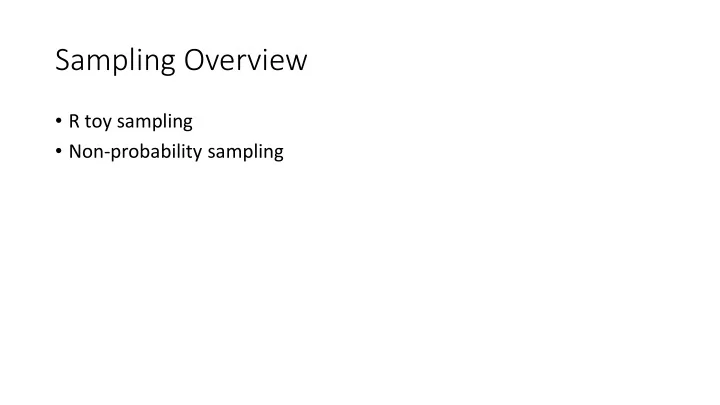

Sampling Overview • R toy sampling • Non-probability sampling
Probability Methods (AKA random) • Why is it be called “probability” sampling? • What are we certain of? • Everyone comfortable with • Simple random sampling • Stratified random sampling • Disproportionate stratified random sampling • Cluster sampling
How big of a sample? • Probability Sampling: • Power Calculations: If you know the size of the effect you expect and the variance of the sample, you can calculate how large of a sample you need to detect that effect (with, for example, 95% confidence). • Probability sampling is only useful with many cases • Rule of thumb: at least 30 • So its not useful for in-depth study of a few cases • We might still start out with random sample though, before we select cases
Nonresponse • When we have random sample, but people refuse to participate. • We can’t assume nonresponse is random. • Often if it’s 20-30% nonresponse, we say it’s not random
Non-probability Methods (AKA non-random) • Why might it be called “non-probability”?
Non-probability Methods (AKA non-random) • Stratified random sampling and cluster sampling are still probability sampling methods • Non-probability methods trade generalizability for logistics • Probability sampling requires a list of all the units in our population • Which we may not have • What populations might it be hard for? • What topics?
Availability Sampling • AKA convenience sampling • Magazine polls of their readership • Polling people who walk by • Amazon Turk • What’s the population you can make an inference about?
Quota Sampling • Quotas to match your sample to the population • 50% women • x% poor, x% rich, x% college educated, etc. • Pros: • Matches the population better • Cons • May not match the population on other dimensions • Especially unobservable dimensions • Requires detailed knowledge about the population
Purposive Sampling • Targets key individuals with important knowledge • e.g. Interview the diplomats who negotiated a particular treaty • e.g. Interview the leaders of an important social movement
Snowball Sampling • Each subject tells you who to talk to next • Hard to reach groups. • Respondent driven sampling • Why is bias a particularly big problem here?
Sample quality • Know what population it represents • Unspecified is no good • Know how cases were selected • systemic, chance driven, haphazard • Sample quality is determined by sample obtained, not by sampling method itself • High nonresponse just as bad as haphazard • Can’t be assumed to move across population • Want to compare important variables across groups
Recommend
More recommend